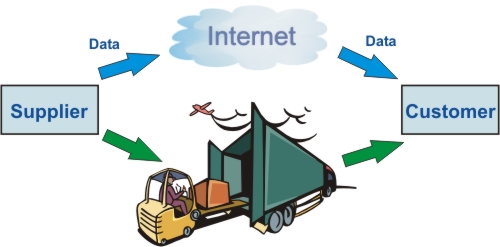
Most BellHawk users are suppliers to larger organizations. They are the Tier 2 organizations in the middle of the supply chain. They supply the Tier 1 organizations that are the link to the retail customers. Many of them are being squeezed by thin margins, global competition, and the incessant need to rapidly deliver quality goods on-time.
So how do our client companies increase sales? They cannot reduce prices any more and high quality is a given. So where is the competitive edge? The answer can be in saving customers money by providing them with data as well as products.
Some of the ways BellHawk users have increased their sales by saving their customer money are:
By saving them money on the receiving dock. They put a barcode or RFID label on each pallet and send an advanced shipment notice describing the contents of each pallet. This can reduce a complex receiving and ERP data entry task for their customers (that has to be performed by an expensive receiving clerk) to a single scan by material-handler driving a fork-lift truck. The result can be savings of tens or even hundreds of thousands of dollars a year to their customers.
By pre-applying all the barcode labels and RFID tags that your customer needs for their internal tracking processes. This saves their customers time and money in their internal tracking processes.
By providing their customers with all the quality control test data in electronic form for the goods that have been shipped. There is no reason that the customer's QC people have to repeat the tests performed by our client's quality control technicians. There is significant cost savings available to customers by reducing the amount of incoming materials inspection. This is going way beyond the provision of a generic certificate of compliance to providing customers with data that will enable their quality control people to truly evaluate the materials that our clients have shipped to them.
By preventing the shipment of defective goods, which could cost our clients' customers a large amount of money in lost production or in defensive incoming inspection. By having electronic mistake prevention systems in place, our clients can demonstrate how they can save their customers these costs and prevent the imposition of penalties for shipment of defective products.
By limiting the customer's liability in the event of the shipment of a batch of defective products. By maintaining electronic tracking and traceability records, our clients are able to minimize the scope of recalls in the event of a defect or contamination. This dramatically reduces the risk and legal liability for the end customer.
Ensuring accurate on-time shipment of materials to customers. This can save the customer money by minimizing their need for inventory. By electronically coordinating the customer's demand with the supplier's production, both our clients and their customers can benefit from considerable cost savings. An extension to this is vendor managed inventory, whereby our client's manage the inventory in their customers' plants based on electronic feedback.
As many of our clients have realized, they cannot reduce prices (without going out of business) and all their competition is claiming to ship quality products. But, by being able to offer these additional savings from supplying data along with their products, our clients are able to compete in another dimension in which the cost savings from improved customer efficiencies more than compensates for a lack of marginal reduction in prices. Also, as these technologies require linking supplier systems with their customer systems, it transitions our clients from being a vendor who can be replaced at will to a valued supplier partner, who cannot be as easily replaced.
All these potential cost savings are not lost on the Tier 1 organizations. So they are starting to mandate that their Tier 2 suppliers be able to provide the data to enable them to make these cost savings. Some well known examples are the US Department of Defense and Veterans Hospital Administration and retail chains such as Wal-Mart but many other examples are starting to occur up and down the supply chain.
| Cost Savings | Technology |

|
Overview | Capabilities |
| Applications | Videos | Software Products | User Manuals | Data Sheets |
| Background | Partner Info | Frequently Asked Questions | Availability | White Papers |
| Technology |

|
Capabilities |
| Availability | Overview | White Papers |
| Background | Data Sheets | Videos |
| Cost Savings | Software Products | User Manuals |
| Partner Info | Frequently Asked Questions | Applications |
Copyright © 2025 Milramco LLC